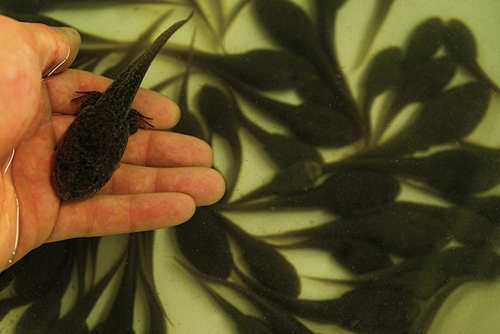 Pond and koi keeping often can require a lot of time and labor. It is a labor of love for many koi fans, but a little help from time to time is greatly appreciated. Sometimes, this assistance comes from the most unlikely of sources. Believe it or not, even Aeromonas has its own helpful qualities.
Pond and koi keeping often can require a lot of time and labor. It is a labor of love for many koi fans, but a little help from time to time is greatly appreciated. Sometimes, this assistance comes from the most unlikely of sources. Believe it or not, even Aeromonas has its own helpful qualities.
Beyond that, there are a number of little helpers that koi keepers can lean on, even in a small way, to help swing the balance of clear water in favor of their “living jewels.” These pond helpers may be small, but they can be quite helpful in keeping in check some of the stuff that can drive a koi enthusiast crazy.
Snails
Snails, some of the more omnipresent helpers, can end up in your pond without you even knowing it. Snails of all kinds can find their way into your koi pond by hitchhiking a ride on the back of another animal or even a plant. Snails can be introduced into a pond’s ecosystem by visitors like turtles or an aquatic plant that is brought in. Some snails will simply migrate to your pond from another area.
Snails are algae eaters. They are like small recycling plants. They will also feed on organic debris like uneaten fish food, leaves or other detritus that falls to the bottom of the pond. Some even claim that by stirring up sediment, they will release some nitrogen. Although they do have a role in helping to keep the water clear, they will not eat the blue-green algae that are the real source of irritation to koi keepers, not to mention a danger to the koi.There are numerous species of snails that are indigenous to different regions. Some are more beneficial than others. Some that rapidly produce offspring can become a nuisance. Many types of snails are hermaphrodites, meaning they can reproduce without mating. It can make for a very crowded pond.
Others may attack pond plants or prefer the beneficial algae that helps to keep the water parameters in check, while skipping the type that can lead to lowered oxygen levels or green water-causing planktonic algae blooms that limit visibility in a pond.
The most regularly recommended pond snail for the job is the Japanese Trapdoor snail, or Viviparus malleattus. Also known as the Chinese Mystery snail, they can get to be 2 to 3 inches when fully grown. They are hardy enough to overwinter in more extreme climates. These critters can handle pH fluctuations anywhere from 6.5 to 8. And what is more, they are not hermaphroditic. They are live-bearing snails and only breed twice a year. Whereas some snail species will view your pond plants as a tasty treat, Japanese Trapdoor snails do not eat plants and instead stick to the nasty stuff that you want out of your pond.

How many will I need to see a difference? The Pond Guy recommends a concentration of 10 snails per 50 square feet, and Dragonfly Aquatics says that one snail for every 20 gallons is the magic number to help clean your pond.
One thing to remember — if you do have snails, do not use algaecides. They will kill off your snail population. Another thing to consider is where you are getting your snails from. Wild snails can, and often will harbor parasites that they will then introduce into your pond. It isn’t a great idea to go snailing and then drop them into your pond. You have no idea where they’ve been! Get to know the species that will best suit your purposes. Some snails can look pretty, but they can become pretty annoying when they multiply rapidly and start to favor your plants over the detritus and algae that you need them to eat.
>> Find more content in our Language of Koi library
If your pond is relatively algae free, one way to dissuade your snails from tucking into your plants is to offer them a leafy alternative, like a lettuce leaf tethered to the bottom of the pond.
Tadpoles
Here’s another little algae-munching helper. Once they have siphoned off the protein from their egg yolk, they will look for another source of food — and the most convenient food is often algae. As a bonus, tadpoles will eat mosquito larvae and help to cull the massive population of this irritating insect.

Tadpoles will eventually become frogs or toads, but many of these frogs will move on once they have shed their tail and grown into their appendages, leaving your pond ready for its next batch of tadpoles. Bullfrogs have been known to eat small koi, so get rid of bullfrogs, just to be safe. But that goes both ways, too. As omnivores, koi will put anything in their mouths that will fit, so they will eat (or, at least, attempt to eat) a small-enough tadpole.
Tadpoles do create an incredible amount of waste — up to five times more than some fish. It is recommended to keep the larger varieties of tadpoles out of small bodies of water like fish bowls or smaller aquariums. They will also eat softer aquatic plants, so be aware of their dietary requirements if you do decide to add tadpoles, or if you see frogs or toads near your pond. There are some varieties of toad tadpoles that produce toxins that can be lethal to koi, but this is extremely rare, as the foul taste usually causes the koi to spit them back out.

If you become concerned that you will have a plague of frogs once the tadpoles grow to maturity, you shouldn’t be. Bullfrogs will thin out their own population through predation. Leopard frogs will leave to seek a new home. Toads will move out to drier areas, as they become land-based, terrestrial creatures upon maturity.
Nature has numerous checks and balances and will generally keep frog and toad populations to a minimum. As a bonus, the fully-grown versions of the tadpoles do like to thin out those insects that can be annoying while you watch your koi in the warmer months.
Hi Fin Banded Sharks

Another fantastic algae-eating pond helper is the Chinese Hi Fin banded shark, or Myxocyprinus asiaticus. As well as being an extremely adaptable fish, the Hi Fin sharks can survive lower pond water temperatures, too, which is good news for pond keepers in those cooler climates with lower winter temperatures. Of course, they prefer the 60-to-80-degree range, but they can withstand temperatures as low as 55 degrees through dormancy. If water temperatures are lower than this, they can start to get stressed.
This mild-mannered, peaceable Chinese sucker fish from the family Catostomidae is compatible to all of your other swimming pond denizens, too. The Hi Fin banded shark prefers to school, so adding two or three to a pond helps them to acclimate to the environment and thrive.
This Yangtze River native species will eat all manners of algae, including green-hair algae, filamentous algae and black brush algae. They will also feast on worms, insects and crustaceans. Chopped-up zucchini sticks are a nice treat, as are seaweed sheets.
Given the right environment and enough space to grow, banded sharks can reach over 3 feet in length and live for longer than 20 years. They grow slowly, so don’t expect them to reach their full length in a short period of time. And because they are algae eaters, they won’t compete with your koi too much for food.
Channel Catfish

The channel catfish (Ictalurus punctatus) is the most populous and popular species of catfish in the United States. They have a forked caudal fin with a curved anal fin, are olive brown to slate in color (sometimes with dark spots on the side), and can grow to be more than 30 pounds. Although they prefer warmer water (60 to 70 degrees), they can handle chillier water, too.
It is true that they are omnivorous, scavenging bottom feeders, so they will munch on pretty much anything that will fit in their mouths. This includes algae, larvae, insects, frogs, invertebrates, koi fry growth and any leftover food and waste that sinks to the bottom.
As a pond mate to your koi, they don’t pose a direct threat to your koi. However, as there is usually a proviso for something that will eat almost anything, a large, hungry catfish will look to supplement its diet where it can. So, there are stories of catfish helping to curate the size of a koi fish population, so to speak. Some catfish, like the blue catfish, can grow to be in excess of 100 pounds. In a small pond, that’s a lot of fish to contend with, especially when they stir up the bottom and contribute to turbidity.
Something else to consider is that the larger they get, the more they will need to eat —: and the more competition your koi will likely face when their other food sources are scarce. But as many stories as there are about aggressive catfish, there are even more about channel catfish, koi and even goldfish coexisting in harmony.
If you are considering introducing a catfish to your koi pond, don’t drop in one from a dubious source. There are outlets that can provide catfish that don’t run the risk of introducing some bacteria or a parasite that hitched a ride from the local stream.
Golden Orfe
Leuciscus idus were the koi in ponds before koi became popular. They prefer and thrive in very much the same water parameters as koi. They can weather cold and heat and like their pH between 7 and 8. Like koi, they can grow to be more than 2 feet long.

They derive their name from the color they reach in maturity, which can range from an orange to a must lustrous golden sheen.
Other than looking tremendous when they school together, they don’t really bring much to the pond party. They do like to catch insects like mosquito larvae, so there is that benefit if you aren’t a big fan of bugs. This torpedo-shaped fish does play well with both koi and goldfish. Like koi, they will, on occasion, eat smaller fish. Orfe can live upward of 30 years when given the right conditions and some other orfe to share their time with.
As you can see, you can enlist the aid of some aquatic allies to help battle algae and assist with the upkeep and overall water quality in your koi pond. Of course, some might be a little better suited to your particular patch of pond life. A little research or reaching out to your local koi society will help inform you which might be your better choice. But most importantly, these are a lot more ecofriendly and attractive than algaecides — and you don’t have to keep it clean alone!


